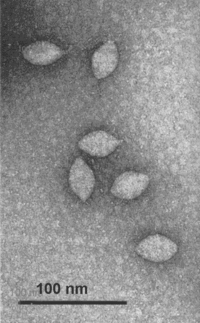Fuselloviridae: Difference between revisions
No edit summary |
No edit summary |
||
| Line 1: | Line 1: | ||
{{Curated}} | |||
{{Viral Biorealm Family}} | {{Viral Biorealm Family}} | ||
Latest revision as of 00:25, 8 August 2010
A Viral Biorealm page on the family Fuselloviridae

Baltimore Classification
Higher order taxa
Viruses; dsDNA viruses, no RNA stage; Fuselloviridae
Genera
Fusellovirus
Description and Significance
Fuselloviridae infect the archaeon Sulfolobus, which inhabits high-temperature (>70°C), acidic (pH of <4.0) environments. Members of this family have been found in acidic hotsprings in Japan and Iceland. The Fuselloviridae family currently consists of only one virus, Sulfolobus spindle-shaped virus 1 (SSV1), and three tentative members (SSV2, SSV3, and the staaelite virus pSSVx, which stands for plasmid SSV x). SSV1, the type virus for the family, was the first high-temperature virus to be characterized. (sources: Wiedenheft et al., Rice et al.)
Genome Structure
The genome of a fuselloviridae is non-segmented and contains a single molecule of circular, double-stranded DNA. The DNA is positively supercoiled. The complete genome is 15500 nucleotides in length. (source: ICTVdB)
Virion Structure of a Fuselloviridae
Fuselloviridae virions consist of an envelope and a nucleocapsid. The capsid is enveloped. Virions are spindle-shaped, flexible, and have protrusions that extend through the envelope. One pole has short tail-like fibers attached to it. The virions are 100 nm in length and 60 nm in diameter. (sources: ICTVdB, Wiedenheft et al.)
Reproduction Cycle of a Fuselloviridae in a Host Cell
The basic replication cycle of crenarchaeal viruses, including Fuselloviruses, has yet to be determined. There are, however, some trends which have been reported. It is thought that members of the Fuselloviridae family, as well as members of the Rudiviridae, Lipothrixviridae, and Guttaviridae families, associate with host cells by tail fibers which are present on one or both ends of the virion. Some viruses integrate their genome into the host cell's chromosome, while others maintain their genomes as extrachromosomal elements.
Assembly and release of most known crenarchaeal viruses, do not require cell lysis. Most crenarchaeal viruses, twith the exception of the Bicaudaviridae member ATV, appear to set up chronic infections, either continually producing virus particles or doing so in short events resulting in growth inhibition. These long-term chronic infections are thought to be an adaptation to the extremely hot and acidic environments crenarchaeal viruses inhabit. (source: Ortmann et al.)
Viral Ecology & Pathology
As mentioned above, viruses in the Fuselloviridae family infect the archaeon Sulfolobus.
References
ICTVdB - The Universal Virus Database, version 3. http://www.ncbi.nlm.nih.gov/ICTVdb/ICTVdB/
Ortmann et al. "Hot crenarchaeal viruses reveal deep evolutionary connections." Nature Reviews Microbiology 4 (2006): 520-528.
